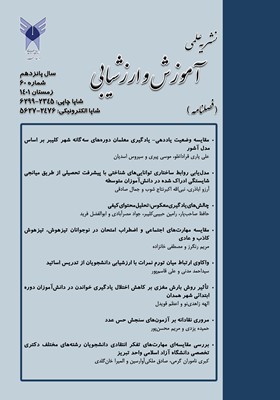مقایسه مهارتهای اجتماعی و اضطراب امتحان در نوجوانان تیزهوش، تیزهوش کاذب و عادی
محورهای موضوعی : روانشناسی تربیتیمریم رنگرز 1 , مصطفی خانزاده 2
1 - کارشناس ارشد روانشناسی عمومی، مؤسسه آموزش عالی فیضالاسلام، خمینی شهر، ایران
2 - استادیار، گروه روانشناسی، مؤسسه آموزش عالی فیضالاسلام، خمینی شهر، ایران.
کلید واژه: اضطراب امتحان, مهارتهای اجتماعی, تیزهوش, نوجوان, تیزهوشکاذب,
چکیده مقاله :
پژوهش با هدف مقایسه مهارتهای اجتماعی و اضطراب امتحان در نوجوانان تیزهوش، تیزهوش کاذب و عادی انجام شد. طرح پژوهش توصیفی و از نوع علیّ-مقایسه ای بود. نمونه پژوهش شامل 147 دانشآموز (50 تیزهوش، 47 تیزهوش کاذب و 50 عادی) بود که از بین دانشآموزان مدارس تیزهوشان و عادی متوسطه اول استان اصفهان به صورت دردسترس و با توجه به ملاک های ورود انتخاب شدند. برای تفکیک دانشآموزان تیزهوش و تیزهوش کاذب از آزمون هوش ریون استفاده شد. افراد نمونه به صورت آنلاین به فرم دانشآموزان دبیرستانی نظام ارزیابی مهارتهای اجتماعی و مقیاس اضطراب امتحان فریدمن پاسخ دادند. داده ها با آزمون تحلیل واریانس چندمتغیری (MANOVA) و آزمون تعقیبی LSD تحلیل شد. نتایج آزمون های چندمتغیری تفاوت کلی و معنادار میانگین مهارتهای اجتماعی و اضطراب امتحان در بین سه گروه را نشان داد. آزمون اثرات بین آزمودنی نشان داد که اثر خودکنترلی و همکاری از ابعاد مهارتهای اجتماعی و خطای شناختی از ابعاد اضطراب امتحان معنادارند. نتایج LSD نشان داد میانگین خودکنترلی دانشآموزان تیزهوش به طور معناداری بزرگتر از سایرین است. میانگین همکاری دانشآموزان تیزهوش کاذب به طور معناداری کمتر از سایرین و میانگین خطای شناختی دانشآموزان تیزهوش کاذب به طور معناداری بیشتر از سایر گروه ها است. نتایج این پژوهش، لزوم تفکیک دانشآموزان تیزهوش کاذب از دانشآموزان تیزهوش در مدارس تیزهوشان ایران را نشان می دهد.
The aim of this study was comparison of social skills and test anxiety in gifted, pseudo-gifted and normal adolescents. The research design was descriptive and causal-comparative. The sample consisted of 147 students (50 gifted, 47 pseudo-gifted and 50 ordinary) who were selected from the gifted and ordinary high school students of Isfahan province using the convenient sampling method and according to the inclusion criteria. Raven IQ test was used to distinguish between gifted and pseudo-gifted students. Participants answered online Social Skills Rating System (SSRS-SS) and the FRIEDBEN Test Anxiety Scale. Data were analyzed using MANOVA and LSD post hoc test. The results of multivariate tests showed a general and significant difference between the mean of social skills and test anxiety between the three groups. The between-subject effects test showed that the effects of self-control and cooperation (social skills), and cognitive obstruction (test anxiety) were significant. The results of LSD showed that the mean of self-control of gifted students is significantly higher than other groups. The mean of cooperation of pseudo- gifted students is significantly lower than other groups. The results of this study show the need to separate pseudo-gifted students from gifted students in gifted schools in Iran.


